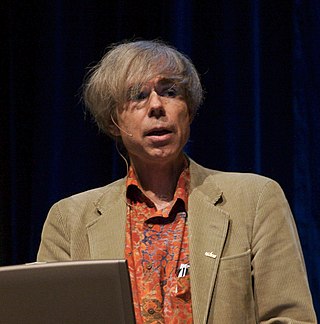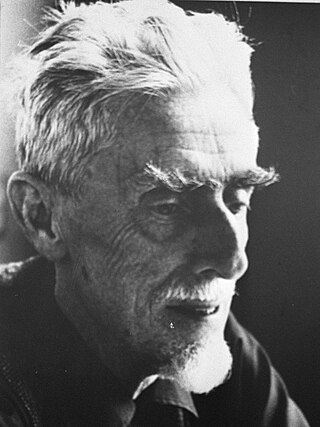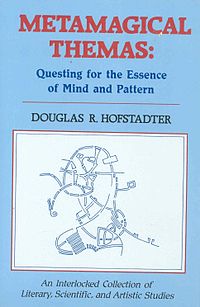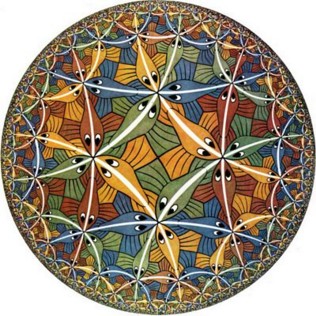
Douglas Richard Hofstadter is an American cognitive and computer scientist whose research includes concepts such as the sense of self in relation to the external world, consciousness, analogy-making, strange loops, artificial intelligence, and discovery in mathematics and physics. His 1979 book Gödel, Escher, Bach: An Eternal Golden Braid won the Pulitzer Prize for general nonfiction, and a National Book Award for Science. His 2007 book I Am a Strange Loop won the Los Angeles Times Book Prize for Science and Technology.

Maurits Cornelis Escher was a Dutch graphic artist who made woodcuts, lithographs, and mezzotints, many of which were inspired by mathematics. Despite wide popular interest, for most of his life Escher was neglected in the art world, even in his native Netherlands. He was 70 before a retrospective exhibition was held. In the late twentieth century, he became more widely appreciated, and in the twenty-first century he has been celebrated in exhibitions around the world.

Self-reference is a concept that involves referring to oneself or one's own attributes, characteristics, or actions. It can occur in language, logic, mathematics, philosophy, and other fields.
A strange loop is a cyclic structure that goes through several levels in a hierarchical system. It arises when, by moving only upwards or downwards through the system, one finds oneself back where one started. Strange loops may involve self-reference and paradox. The concept of a strange loop was proposed and extensively discussed by Douglas Hofstadter in Gödel, Escher, Bach, and is further elaborated in Hofstadter's book I Am a Strange Loop, published in 2007.

Gödel, Escher, Bach: an Eternal Golden Braid, also known as GEB, is a 1979 book by Douglas Hofstadter.

Metamagical Themas is an eclectic collection of articles that Douglas Hofstadter wrote for the popular science magazine Scientific American during the early 1980s. The anthology was published in 1985 by Basic Books.

The Art of Fugue, or The Art of the Fugue, BWV 1080, is an incomplete musical work of unspecified instrumentation by Johann Sebastian Bach. Written in the last decade of his life, The Art of Fugue is the culmination of Bach's experimentation with monothematic instrumental works.
BlooP and FlooP are simple programming languages designed by Douglas Hofstadter to illustrate a point in his book Gödel, Escher, Bach. BlooP is a Turing-incomplete programming language whose main control flow structure is a bounded loop. All programs in the language must terminate, and this language can only express primitive recursive functions.

Reptiles is a lithograph print by the Dutch artist M. C. Escher first printed in March 1943. It touches on the theme found in much of his work of mathematics in art.

In Western art history, mise en abyme is the technique of placing a copy of an image within itself, often in a way that suggests an infinitely recurring sequence. In film theory and literary theory, it refers to the story within a story technique.

A Bongard problem is a kind of puzzle invented by the Soviet computer scientist Mikhail Moiseevich Bongard, probably in the mid-1960s. They were published in his 1967 book on pattern recognition. The objective is to spot the differences between the two sides. Bongard, in the introduction of the book credits the ideas in it to a group including M. N. Vaintsvaig, V. V. Maksimov, and M. S. Smirnov.

Drawing Hands is a lithograph by the Dutch artist M. C. Escher first printed in January 1948. It depicts a sheet of paper, out of which two hands rise, in the paradoxical act of drawing one another into existence. This is one of the most obvious examples of Escher's common use of paradox.

Egbert B. Gebstadter is a fictional author who appears in the indices of books by Douglas R. Hofstadter. For each Hofstadter book, there is a corresponding Gebstadter book. His name is derived from "GEB", the abbreviation for Hofstadter's first book Gödel, Escher, Bach: An Eternal Golden Braid; the letters appear in his last name, permuted in his first name, and permuted again in his initials.
The MU puzzle is a puzzle stated by Douglas Hofstadter and found in Gödel, Escher, Bach involving a simple formal system called "MIU". Hofstadter's motivation is to contrast reasoning within a formal system against reasoning about the formal system itself. MIU is an example of a Post canonical system and can be reformulated as a string rewriting system.

I Am a Strange Loop is a 2007 book by Douglas Hofstadter, examining in depth the concept of a strange loop to explain the sense of "I". The concept of a strange loop was originally developed in his 1979 book Gödel, Escher, Bach.
In the end, we are self-perceiving, self-inventing, locked-in mirages that are little miracles of self-reference.

Mathematics and art are related in a variety of ways. Mathematics has itself been described as an art motivated by beauty. Mathematics can be discerned in arts such as music, dance, painting, architecture, sculpture, and textiles. This article focuses, however, on mathematics in the visual arts.

Print Gallery is a lithograph printed in 1956 by the Dutch artist M. C. Escher. It depicts a man in a gallery viewing a print of a seaport, and among the buildings in the seaport is the very gallery in which he is standing, making use of the Droste effect with visual recursion. The lithograph has attracted discussion in both mathematical and artistic contexts. Escher considered Print Gallery to be among the best of his works.

Circle Limit III is a woodcut made in 1959 by Dutch artist M. C. Escher, in which "strings of fish shoot up like rockets from infinitely far away" and then "fall back again whence they came".

Double Planetoid is a wood engraving print by the Dutch artist M. C. Escher, first printed in 1949.

Day and Night is a woodcut made by the Dutch artist M. C. Escher in 1938.

















